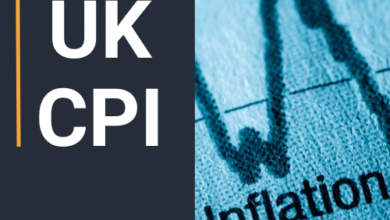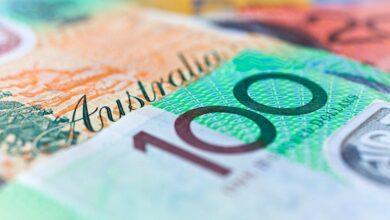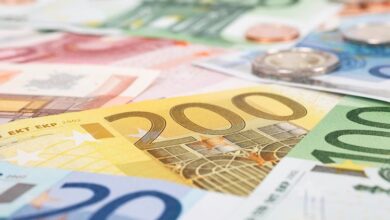Gold eases from multi-month peak, dovish Fed expectations favour bulls ahead of US GDP

- Gold price gains positive traction for the sixth straight day and refreshes its multi-month top.
- Dovish Fed expectations, falling US bond yields and a bearish USD continue to lend support.
- The overbought RSI on the daily chart warrants caution before placing fresh bullish bets.
Gold price (XAU/USD) advanced to a near seven-month peak, around the $2,052 area on Wednesday, albeit trims a part of its intraday gains heading into the European session. A modest US Dollar (USD) bounces off its lowest level since August 11 touched earlier today, along with a generally positive risk tone, caps gains for the precious metal. The commodity, however, manages to hold in positive territory for the fifth straight day – also the sixth day in the previous seven – and seems poised to appreciate further in the wake of expectations that the Federal Reserve (Fed) will no longer raise interest rates.
Moreover, the overnight less hawkish remarks by Fed Governor Christopher Waller reaffirmed market bets that the US central bank may begin easing its monetary policy as early as March 2024. Apart from this, the underwhelming US bond auction on Tuesday drags the yield on the benchmark 10-year US government bond further below the 100-day Simple Moving Average (SMA). This should keep a lid on any meaningful USD recovery and should continue to act as a tailwind for the non-yielding Gold price. Traders might also refrain from placing aggressive bets ahead of the key macro data from the US.
The prelim or the second estimate of the US GDP report is due for release later during the early North American session and is expected to show that the world’s largest economy expanded by a 5% annualized pace during the third quarter as against the 4.9% growth reported previously. Apart from this, Fedspeaks will drive the USD demand and produce short-term trading opportunities around the Gold price. The focus, however, will remain on the crucial US inflation data on Thursday, which might influence the Fed’s near-term policy outlook and provide a fresh impetus to the precious metal.
Daily Digest Market Movers: Gold price takes a brief pause after rising to a fresh multi-month peak
- The US Dollar rebounds from over a three-and-half-month low and acts as a headwind for the Gold price, though bets for rate cuts by the Federal Reserve in 2024 continue to lend support.
- Fed Governor Christopher Waller said on Tuesday that he could see a point where the central bank might start lowering rates if inflation continues to ease over the next few months.
- Waller added that he is increasingly confident that policy is currently well-positioned to slow the economy and get inflation back to the central bank’s 2% target.
- Fed Governor Michelle Bowman offered a contrasting view and reiterated her belief that more rate hikes likely will be needed as evolving dynamics keep inflation elevated.
- Markets expect the Fed to hold its key lending rate steady in a target range between 5.25%-5.5% in December, though officials have stressed the need to remain vigilant on inflation and keep their options open.
- The Israel-Hamas ceasefire deal has been extended by two days beyond its original expiration on Tuesday morning, which could dim the metal’s safe-haven appeal.
- Hamas released about 50 hostages as part of the original agreement and is expected to free another 20 over the next two days in exchange for the release of Palestinian prisoners by Israel.
- Traders now look to the prelim US GDP report, which is expected to show that the world’s largest economy expanded by a 5% annualized pace during the third quarter as against the 4.9% estimated.
- The market attention will then shift to the US Core PCE Price Index – the Fed’s preferred benchmark for measuring longer-term inflation trends on Thursday.
Technical Analysis: Gold price bulls retain control, dips might still be seen as a buying opportunity
From a technical perspective, this week’s sustained breakout through the $2,008-2,010 barrier and the subsequent move-up support prospects for a further appreciating move. That said, the Relative Strength Index (RSI) on the daily chart is flashing slightly overbought conditions and warrants some caution for bullish traders. Hence, it will be prudent to wait for some near-term consolidation or a modest pullback before positioning for additional gains.
Any corrective pullback below the Asian session low, however, is likely to find decent support and attract fresh buyers near the $2,035-2,034 region. This should help limit the downside for the Gold price near the $2,020 level, which should now act as a key pivotal point. On the flip side, some follow-through buying beyond the $2,052 region, or a multi-month top touched earlier this Wednesday, will set the stage for a move towards challenging the all-time high, around the $2,079-2,080 zone set in May.
US Dollar price this month
The table below shows the percentage change of US Dollar (USD) against listed major currencies this month. US Dollar was the weakest against the New Zealand Dollar.
| USD | EUR | GBP | CAD | AUD | JPY | NZD | CHF | |
| USD | -3.99% | -4.61% | -2.44% | -4.95% | -2.76% | -6.60% | -3.76% | |
| EUR | 3.83% | -0.60% | 1.51% | -0.94% | 1.18% | -2.53% | 0.22% | |
| GBP | 4.43% | 0.61% | 2.11% | -0.32% | 1.77% | -1.90% | 0.84% | |
| CAD | 2.37% | -1.52% | -2.14% | -2.47% | -0.32% | -4.07% | -1.29% | |
| AUD | 4.73% | 0.92% | 0.34% | 2.39% | 2.08% | -1.57% | 1.15% | |
| JPY | 2.68% | -1.19% | -1.79% | 0.33% | -2.13% | -3.75% | -0.93% | |
| NZD | 6.19% | 2.46% | 1.87% | 3.92% | 1.54% | 3.60% | 2.70% | |
| CHF | 3.63% | -0.22% | -0.81% | 1.27% | -1.16% | 0.93% | -2.74% |
The heat map shows percentage changes of major currencies against each other. The base currency is picked from the left column, while the quote currency is picked from the top row. For example, if you pick the Euro from the left column and move along the horizontal line to the Japanese Yen, the percentage change displayed in the box will represent EUR (base)/JPY (quote).
Interest rates FAQs
Interest rates are charged by financial institutions on loans to borrowers and are paid as interest to savers and depositors. They are influenced by base lending rates, which are set by central banks in response to changes in the economy. Central banks normally have a mandate to ensure price stability, which in most cases means targeting a core inflation rate of around 2%.
If inflation falls below target the central bank may cut base lending rates, with a view to stimulating lending and boosting the economy. If inflation rises substantially above 2% it normally results in the central bank raising base lending rates in an attempt to lower inflation.
Higher interest rates generally help strengthen a country’s currency as they make it a more attractive place for global investors to park their money.
Higher interest rates overall weigh on the price of Gold because they increase the opportunity cost of holding Gold instead of investing in an interest-bearing asset or placing cash in the bank.
If interest rates are high that usually pushes up the price of the US Dollar (USD), and since Gold is priced in Dollars, this has the effect of lowering the price of Gold.
The Fed funds rate is the overnight rate at which US banks lend to each other. It is the oft-quoted headline rate set by the Federal Reserve at its FOMC meetings. It is set as a range, for example 4.75%-5.00%, though the upper limit (in that case 5.00%) is the quoted figure.
Market expectations for future Fed funds rate are tracked by the CME FedWatch tool, which shapes how many financial markets behave in anticipation of future Federal Reserve monetary policy decisions.
Get Best News and Web Services here







